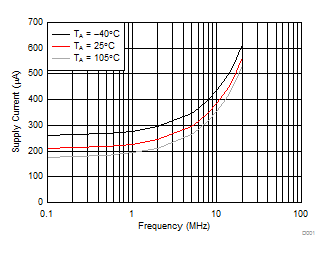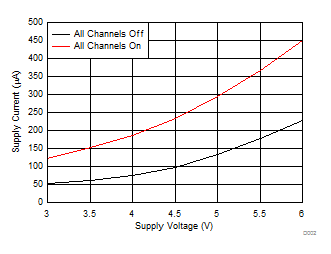JAJSC76 May 2016 TLC6C5912
PRODUCTION DATA.
6 Specifications
6.1 Absolute Maximum Ratings
over operating free-air temperature range (unless otherwise noted)(1)| MIN | MAX | UNIT | |||
|---|---|---|---|---|---|
| VCC | Logic supply voltage | 8 | V | ||
| VI | Logic input-voltage | –0.3 | 8 | V | |
| VDS | Power DMOS drain-to-source voltage | 42 | V | ||
| Continuous total dissipation | See Thermal Information | ||||
| Operating ambient temperature (Top) | 105 | °C | |||
| TJ | Operating junction temperature | –40 | 125 | °C | |
| Tstg | Storage temperature | –55 | 165 | °C | |
(1) Stresses beyond those listed under Absolute Maximum Ratings may cause permanent damage to the device. These are stress ratings only, which do not imply functional operation of the device at these or any other conditions beyond those indicated under Recommended Operating Conditions. Exposure to absolute-maximum-rated conditions for extended periods may affect device reliability.
6.2 ESD Ratings
| VALUE | UNIT | |||
|---|---|---|---|---|
| V(ESD) | Electrostatic discharge | Human-body model (HBM), per ANSI/ESDA/JEDEC JS-001(1) | ±2000 | V |
| Charged-device model (CDM), per JEDEC specification JESD22-C101(2) | ±750 | |||
(1) JEDEC document JEP155 states that 500-V HBM allows safe manufacturing with a standard ESD control process.
(2) JEDEC document JEP157 states that 250-V CDM allows safe manufacturing with a standard ESD control process.
6.3 Recommended Operating Conditions
| MIN | MAX | UNIT | ||
|---|---|---|---|---|
| VCC | Supply voltage | 3 | 5.5 | V |
| VIH | High-level input voltage | 2.4 | V | |
| VIL | Low-level input voltage | 0.7 | V | |
| tsu | Setup time, SER IN high before SRCK↑ | 15 | ns | |
| th | Hold time, SER IN high after SRCK↑ | 15 | ns | |
| tw | Pulse duration | 40 | ns | |
| TA | Operating ambient temperature | –40 | 105 | °C |
6.4 Thermal Information
| THERMAL METRIC(1) | TLC6C5912 | UNIT | |
|---|---|---|---|
| PW (TSSOP) | |||
| 20 PINS | |||
| RθJA | Junction-to-ambient thermal resistance | 114.8 | °C/W |
| RθJC(top) | Junction-to-case (top) thermal resistance | 44.1 | °C/W |
| RθJB | Junction-to-board thermal resistance | 61.3 | °C/W |
| ψJT | Junction-to-top characterization parameter | 4.7 | °C/W |
| ψJB | Junction-to-board characterization parameter | 60.8 | °C/W |
(1) For more information about traditional and new thermal metrics, see the Semiconductor and IC Package Thermal Metrics application report, SPRA953.
6.5 Electrical Characteristics
VCC = 5 V, TA = 25°C (unless otherwise noted)| PARAMETER | TEST CONDITIONS | MIN | TYP | MAX | UNIT | ||
|---|---|---|---|---|---|---|---|
| DRAIN0 to DRAIN11, drain-to-source voltage |
40 | V | |||||
| VOH | High-level output voltage, SER OUT |
IOH = –20 μA | VCC = 5 V | 4.9 | 4.99 | V | |
| IOH = –4 mA | 4.5 | 4.69 | |||||
| VOL | Low-level output voltage, SER OUT |
IOH = 20 μA | VCC = 5 V | 0.001 | 0.01 | V | |
| IOH = 4 mA | 0.25 | 0.4 | |||||
| IIH | High-level input current | VCC = 5 V, VI = VCC | 0.2 | μA | |||
| IIL | Low-level input current | VCC = 5 V, VI = 0 | –0.2 | μA | |||
| ICC | Logic supply current | VCC = 5 V, No clock signal |
All outputs off | 0.1 | 1 | μA | |
| All outputs on | 130 | 170 | |||||
| ICC(FRQ) | Logic supply current at frequency | fSRCK = 5 MHz, CL = 30 pF, all outputs on | 300 | µA | |||
| IDSX | Off-state drain current | VDS = 30 V, VCC = 5 V | 0.1 | μA | |||
| VDS = 30 V, TC = 125°C, VCC = 5 V | 0.15 | 0.3 | |||||
| rDS(on) | Static drain-source on-state resistance | ID = 20 mA, VCC = 5 V, TA = 25°C, single channel ON | 6 | 7.4 | 8.6 | Ω | |
| ID = 20 mA, VCC = 5 V, TA = 25°C, all channels ON | 6.7 | 8.9 | 9.6 | ||||
| ID = 20 mA, VCC = 3.3 V, TA = 25°C, single channel ON | 7.9 | 9.3 | 11.2 | ||||
| ID = 20 mA, VCC = 3.3 V, TA = 25°C, all channels ON | 8.7 | 10.6 | 12.3 | ||||
| ID = 20 mA, VCC = 5 V, TA = 105°C, single channel ON | 9.1 | 11.2 | 12.9 | ||||
| ID = 20 mA, VCC = 5 V, TA = 105°C, all channels ON | 10.3 | 13 | 14.5 | ||||
| ID = 20 mA, VCC = 3.3 V, TA = 105°C, single channel ON | 11.6 | 13.7 | 16.4 | ||||
| ID = 20 mA, VCC = 3.3 V, TA = 105°C, all channels ON | 12.8 | 15.6 | 18.2 | ||||
| TSHUTDOWN | Thermal shutdown trip point | 150 | 175 | 200 | °C | ||
| tHYS | Hysteresis | 15 | °C | ||||
6.6 Switching Characteristics
VCC = 5 V, TA = 25°C| PARAMETER | TEST CONDITIONS | MIN | TYP | MAX | UNIT | |
|---|---|---|---|---|---|---|
| tPLH | Propagation delay time, low-to-high-level output from G | CL = 30 pF, ID = 48 mA | 210 | ns | ||
| tPHL | Propagation delay time, high-to-low-level output from G | 75 | ns | |||
| tr | Rise time, drain output | 250 | ns | |||
| tf | Fall time, drain output | 200 | ns | |||
| tpd | Propagation delay time, SRCK↓ to SEROUT | CL = 30 pF, ID = 48 mA | 35 | ns | ||
| tor | SEROUT rise time (10% to 90%) | CL = 30 pF | 20 | ns | ||
| tof | SEROUT fall time (90% to 10%) | CL = 30 pF | 20 | ns | ||
| f(SRCK) | Serial clock frequency | CL = 30 pF, ID = 20 mA | 10 | MHz | ||
| tSRCK_WH | SRCK pulse duration, high | 30 | ns | |||
| tSRCK_WL | SRCK pulse duration, low | 30 | ns | |||
 Figure 1. SER IN to SER OUT Waveform
Figure 1. SER IN to SER OUT Waveform
Figure 1 shows the SER IN to SER OUT waveform. The output signal appears on the falling edge of the shift register clock (SRCK) because there is a phase inverter at SER OUT (see Figure 2). As a result, it takes seven and a half periods of SRCK for data to transfer from SER IN to SER OUT.
 Figure 2. Switching Times and Voltage Waveforms
Figure 2. Switching Times and Voltage Waveforms
Figure 2 shows the switching times and voltage waveforms. Tests for all these parameters took place using the test circuit shown in Figure 12.
6.7 Typical Characteristics
Conditions for Figure 5 and Figure 6: Single channel on; conditions for Figure 7, Figure 8, and Figure 9: All channels on.
| VCC = 5 V |

| VCC = 5 V |
vs Drain Current (Single Channel On)

| VCC = 5 V |
vs Drain Current (All Channels On)

| I(ds) = 20 mA |
vs Supply Voltage

| VCC |

| VCC = 3.3 V |
vs Drain Current (Single Channel On)

| VCC = 3.3 V |
vs Drain Current (All Channels On)
